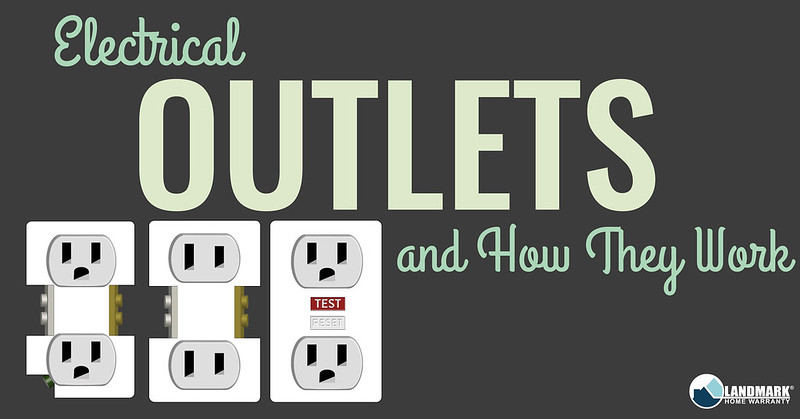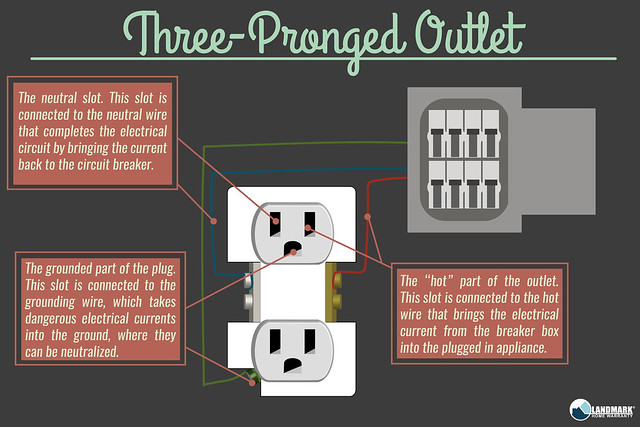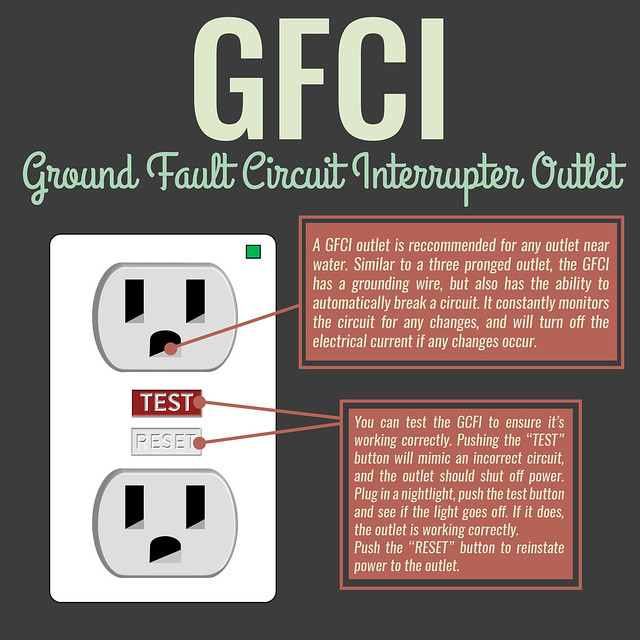THE MATERIAL CONTAINED IN THIS ARTICLE IS PROVIDED FOR GENERAL INFORMATION PURPOSES ONLY AND DOES NOT CONSTITUTE PROFESSIONAL ADVICE.LANDMARK HOME WARRANTY DOES NOT PURPORT TO BE A SUBJECT MATTER EXPERT WITH REGARD TO THIS MATERIAL, AND YOU SHOULD CONDUCT YOUR OWN RESEARCH AND/OR SEEK THE ADVICE OF APPROPRIATELY QUALIFIED PROFESSIONALS WITH REGARD TO YOUR SPECIFIC CIRCUMSTANCES BEFORE YOU TAKE ACTION. LANDMARK HOME WARRANTY ASSUMES NO RESPONSIBILITY, AND SPECIFICALLY DISCLAIMS ALL LIABILITY, FOR YOUR USE OF ANY AND ALL INFORMATION CONTAINED HEREIN.
Turning on a lamp, starting the microwave, or flipping on the TV are such every day tasks that you hardly think about what has to happen within the walls of your home for those items to work. Electricity is an important part of the systems within your house and being able to understand how it works is vital in order to do simple things like resetting a circuit breaker or testing an outlet.
This article will walk you through how a basic electrical outlet works, and a few different types of outlets you may have in your home.
How an Electric Outlet Works
In order for electricity to work, it needs to create a circuit. An electrical outlet is the source of electrical power you use to plug in many of your appliances, which is how you create that circuit in your home. Here is how an electrical outlet works:
The circuit breaker is connected to each of your outlets by wiring.
An outlet has three holes. The first hole, or left hole, is called “neutral”. The second hole, or right hole, is called “hot”. The third hole is the ground hole. The hot hole is connected to the wire that supplies the electrical current. The neutral hole is connected to the wire that brings the electrical current back to the breaker box. When you plug in a lamp and turn it on, the hot part of the outlet allows electricity to flow into the lamp, turning on the light bulb. The circuit is completed when the current is brought back into the outlet through the neutral slot, and back into the circuit breaker. When you unplug the lamp the circuit is broken and thus the lamp doesn’t work.
A circuit breaker is one level of protection in a home. It’s called a circuit breaker because it will “trip” or “break” a circuit (stop electric current from flowing) if the electric current is too high. Another level of safety for your home’s electrical system is having a grounded wire and grounded outlets.
What is the difference between a two-pronged and three-pronged/grounded outlet?
If you live in an older home, you may have outlets that don’t have a third or “grounded” hole. These outlets do not have a grounding wire within the electrical system. Because having a grounding wire and grounded (three-pronged) outlets adds an extra level of safety, newer houses and buildings are required to have three-pronged outlets with grounding wires. A grounding wire is connected separately to each outlet, and then is connected to the bottom of the breaker box. This grounding wire neutralizes any dangerous electrical current into the ground.
A grounding line is used to protect your appliances from surges or overvoltage problems. It also stabilizes voltage and protects people, properties, and equipment from electric shock.
For example, say something happened to the hot wire in the plug. When you plugged something into a two-pronged outlet you would most likely get a shock. The appliance you were trying to plug in could also get a large electric current, potentially ruining it.
If the same thing occurred with a three-pronged outlet and you plugged something (with three prongs) into the outlet, the ground wire would absorb the shock and take the current into the ground where it can be safely neutralized. Granted, the plug still wouldn’t be working, but it also wouldn’t be ruining your appliances… or you.
If you have a two-pronged outlet and you have three pronged appliances (as many people do), what do you do? Well, you could use what is called a “cheat” plug. The plug plugs into your two-pronged outlet, but has three prongs. However, this will not protect your electrical outlet, walls, insulation or your appliances from electrical shocks. You need a grounding wire in your electrical set up to ensure that you’re safe.
If you have a home where you do not have grounded plugs or a grounded wire, you may want to talk to a qualified electrician to get a grounded wire put into your home’s electrical system.
What is a GFCI outlet?
Another type of plug you may have in your home is a GFCI outlet, or a Ground Fault Circuit Interrupter outlet. This type of outlet is usually found anywhere in your home where the outlet (or things plugged into an outlet) could potentially get in contact with water. It protects you from electric shock and is a great safety feature for kitchens or bathrooms.
A GFCI outlet is an extremely sensitive outlet that monitors the current passing through it. If there’s a slight change in current coming back from the equipment plugged into the outlet, the GFCI will automatically disconnect the circuit so the electrical current is no longer flowing.
For example, if you are using a radio, or hair dryer and it falls into a bath or sink full of water, the electricity would skip the neutral wire and go into the water… and then into you, giving you a potentially life-ending shock. With a GFCI outlet, the outlet would automatically shut off the electric current the moment there was no electric current coming back through the neutral wire, thus saving your life.
GFCI outlets should be installed anywhere there is the potential for water to come in contact with the outlet or what is plugged into the outlet. This means places like your kitchen, bathroom, by your water heater, by your furnace, and outside of your home should all have GFCI outlets. If your home does not have GFCI outlets in these places, consider having an electrician replace them or do it yourself.
GFCI outlets are also easily tested to ensure they are working properly. They have a “test” and “reset” button that can trip the outlet to ensure that if the outlet did show a variance in current, it would shut down power.
Landmark Home Warranty protects the electrical system within your home with even our most basic plans because we know how integral electricity is within our homeowner’s lives. If you have outlets that are not working, give us a call and open a claim. We repair or replace all failed outlets for a small service call fee! You can have your failed electrical outlets repaired or replaced by a qualified electrician by giving us a call.
If you’re interested in having your electrical system (or a number of other home systems and appliances) protected with a home warranty, check out our plans and pricing and get a free, personalized home warranty quote for your home, here, today!




